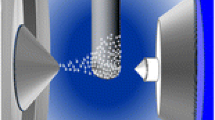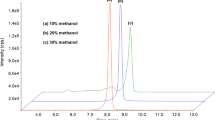Abstract
In the method described here, an aliquot of a urine sample is analyzed to detect barbiturates through dilution and ultra-high-performance chromatography-tandem mass spectrometry (UPLC-MS/MS) using deuterated internal standards. This assay detects the presence of nine barbiturate drugs—amobarbital, barbital, butalbital, butabarbital, mephobarbital, secobarbital, pentobarbital, phenobarbital, and thiopental. This protocol describes two LC separation methods—first LC method (2.2 min/sample) is intended to be used as a first step of the analysis that does not separate amobarbital and pentobarbital, and a second, longer (2.7 min/sample) LC method is intended to be used only for samples which have a peak in the amobarbital/pentobarbital retention time on the shorter LC method. Since the frequency at which amobarbital and pentobarbital are observed in clinical populations is low, the shorter LC method helps gain efficiency in a high-volume laboratory environment. Additional features of this protocol that help in efficiency gain are automated extraction using Hamilton™ liquid handling system and algorithmic data review using Ascent™ software.
Access this chapter
Tax calculation will be finalised at checkout
Purchases are for personal use only
Similar content being viewed by others
References
Cozanitis DA (2004) One hundred years of barbiturates and their saint. J R Soc Med 97(12):594–598. https://doi.org/10.1258/JRSM.97.12.594
Ernst B, Clark G, Grundmann O (2015) The physicochemical and pharmacokinetic relationships of barbiturates – from the past to the future. Curr Pharm Des 21(25):3681–3691. https://doi.org/10.2174/1381612821666150331131009
Löscher W, Rogawski MA (2012) How theories evolved concerning the mechanism of action of barbiturates. Epilepsia 53:12–25. https://doi.org/10.1111/EPI.12025
Suddock JT, Cain MD. Barbiturate toxicity. Published online 2023. Accessed 29 Mar 2023. https://pubmed.ncbi.nlm.nih.gov/29763050/
Opheim KE, Raisys VA (1985) Therapeutic drug monitoring in pediatric acute drug intoxications. Ther Drug Monit 7(2):148–158. https://doi.org/10.1097/00007691-198506000-00003
Guale F, Shahreza S, Walterscheid JP et al (2013) Validation of LC-TOF-MS screening for drugs, metabolites, and collateral compounds in forensic toxicology specimens. J Anal Toxicol 37(1):17–24. https://doi.org/10.1093/jat/bks084
Hori Y, Fujisawa M, Shimada K, Hirose Y, Yoshioka T (2006) Method for screening and quantitative determination of serum levels of salicylic acid, acetaminophen, theophylline, phenobarbital, bromvalerylurea, pentobarbital, and amobarbital using liquid chromatography/electrospray mass spectrometry. Biol Pharm Bull 29(1):7–13. https://doi.org/10.1248/BPB.29.7
Johnson LL, Garg U (2010) Quantitation of amobarbital, butalbital, pentobarbital, phenobarbital, and secobarbital in urine, serum, and plasma using gas chromatography-mass spectrometry (GC-MS). Methods Mol Biol 603:65–74. https://doi.org/10.1007/978-1-60761-459-3_7
Liu Y, Uboh CE, Li X et al (2017) Validated LC–MS-MS method for simultaneous analysis of 17 barbiturates in horse plasma for doping control. J Anal Toxicol 41(5):431–440. https://doi.org/10.1093/JAT/BKX025
Author information
Authors and Affiliations
Corresponding author
Editor information
Editors and Affiliations
Rights and permissions
Copyright information
© 2024 The Author(s), under exclusive license to Springer Science+Business Media, LLC, part of Springer Nature
About this protocol
Cite this protocol
Campbell, M., Janis, G., Horne, H., Ketha, H. (2024). Analysis of Barbiturates in Urine by LC-MS/MS. In: Garg, U. (eds) Clinical Applications of Mass Spectrometry in Drug Analysis. Methods in Molecular Biology, vol 2737. Humana, New York, NY. https://doi.org/10.1007/978-1-0716-3541-4_8
Download citation
DOI: https://doi.org/10.1007/978-1-0716-3541-4_8
Published:
Publisher Name: Humana, New York, NY
Print ISBN: 978-1-0716-3540-7
Online ISBN: 978-1-0716-3541-4
eBook Packages: Springer Protocols




